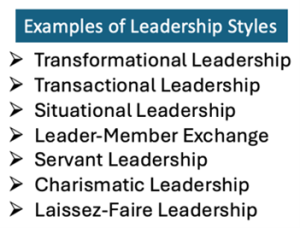
Leadership Styles Aren’t Prescriptions
There’s a chance that your company prefers a certain type of leadership style, for example, an acquaintance recently sat through training at their company around the approach of servant leadership. However, you’ll find that you cannot expect someone to perform successfully without giving thought or consideration to their own strengths, weaknesses, and individual dispositions—this speaks to role “fit” which we will talk about shortly.
This is not to say managers (for example) can’t be taught or ever adapt to new styles of leadership; many who do can be very successful. But it cannot be overlooked that a part of their success likely stems from the fact that the types of leadership styles you’re utilizing already match their individual traits, skills, and personalities in some or many ways.
You may have seen individuals with good intentions try to adopt or mirror the approach of another leader who has been very successful. It’s possible that the approach to the leadership style was the same, but the application was lacking because of the differing traits and innate styles of the individuals.
Fitting Versus Forcing Different Leadership Styles
As we consider the individuality of our leaders, as well as the many different leadership types, matching an individual with a particular leadership style (as prescribed by the company) will need to consider fit (i.e. personality, communication approach, etc.) in conjunction with understanding the hallmarks that identify the prescribed leadership approach. This goes beyond simply prescribing a style that forces potential leaders to operate against their nature. In fact, part of a successful process means that the individual should have a deeper understanding of themselves as, after all, the consideration of role fit is a two-way street. Without this attention from both sides, businesses could be forcing a square peg of leadership into a round hole of skills, traits, and behaviors, leading to discouragement, frustration, and ineffectiveness for all.
In this manner and with input and effort from both sides, organizations that do want to adopt particular leadership styles can avoid training the wrong people for those positions by matching the individual hired or promoted to the leadership types desired. For example, if a company wanted to adopt servant leadership, they might not want to hire legendary basketball coach Bobby Knight—a man known for his volatile outbursts and outspoken nature. However, there’s no debate that Knight was a great leader, coaching over 900 games and winning numerous championships during his career. But if you had asked Knight to switch his style, he would likely not have been successful simply because it goes against his personality.
You Don’t Have to Choose Your Types of Leadership
The good news is that nothing says leaders need to adopt or stick to one leadership style. In fact, the best (and likely more realistic) situation involves a mix of many leadership skills and styles depending on the context. Of the thousands of people interviewed for Dale Carnegie’s research each year surrounding a variety of workplace topics that includes leadership, we cannot recall a response where a participant wished their company would adopt a leadership type. People are dynamic; the work environment is dynamic; your particular approach and combination to achieve success in these conditions will likely be just as varied.
Every type of leadership has its pros and cons, which makes it difficult to assign one “best” style to the needs of any organization. The fact that research into different leadership types remains so prevalent speaks to the fact that no single style holds the answer to effective leadership.
Start with the Individual
While adopting a leadership style within an organization and then searching for the right fit is one approach (somewhat of a hammer looking for a nail), consider starting with the individual first. Consider their existing qualities that have you interested in them for leadership in the first place. Together, identify their strengths, weaknesses, communication style, and other innate leadership skills as you help them cultivate an approach that not only fits them but also ultimately benefits the company. In doing so, you can then seek or provide tailored training to further develop that individual where they need improvement, and with this approach, you will likely find yourself pulling from various leadership styles to provide the greatest opportunity for effectiveness for not only that individual but ultimately your teams and organization as a result.
Whatever approach you choose, be sure that the needs of each leadership role align with the individual style and approach of the leader to create the greatest possible success. If you need help leveling up your workers to the leaders you want them to be, look to Dale Carnegie. Through our targeted training, we provide a chance for leaders to grow and find and develop the styles of leadership that work for them and your company for the greatest chance at success. For more information, visit dalecarnegie.com.sg or search our courses.